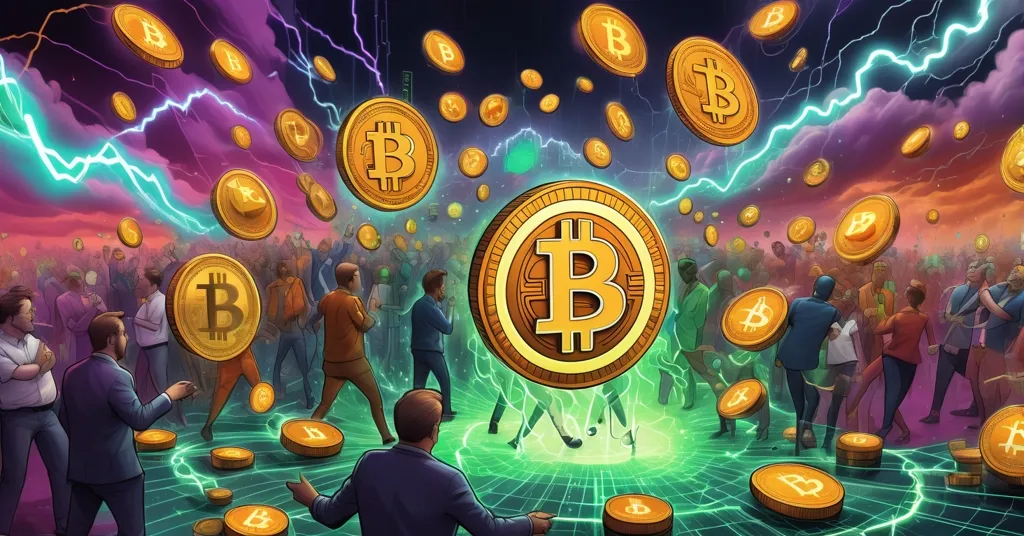Crypto Price Buzz: XRP, PUMP, and Bitcoin Cash Predictions for August 13 Spotlight

Crypto Price Predictions: XRP, PUMP, and Bitcoin Cash Under the Spotlight for August 13
Bitcoin’s rumored surge past $120,000 has set the crypto world ablaze, but it’s not the only name grabbing attention on August 13. From Ripple’s XRP posting monstrous gains to the chaotic meme coin frenzy of Pump.fun (PUMP) and the steady climb of Bitcoin Cash (BCH), the market is a mixed bag of opportunity and uncertainty. Add in fresh players like Bitcoin Hyper (HYPER) and a potentially shifting U.S. regulatory scene, and you’ve got a perfect storm of hype and hard realities. Let’s break it down with no fluff and plenty of scrutiny.
- Bitcoin’s Rumored Peak: Reports of a $122,838 high spark rally talk, but data needs confirmation.
- XRP’s Massive Rally: A 466% yearly surge, fueled by legal wins and institutional interest.
- PUMP’s Wild Ride: Solana-based meme coin platform shows volatile promise.
- BCH’s Steady Climb: Doubled since April with bullish signals for more gains.
- Regulatory Winds: U.S. moves like the GENIUS Act could change the game—or complicate it.
Bitcoin’s Momentum: Fact or Fiction?
Bitcoin, the heavyweight champ of crypto with a $2.3 trillion market cap, is reportedly smashing records again. Numbers floating around suggest it hit $122,838 last month and nearly topped that at $122,227 recently. For perspective, Bitcoin’s halving earlier this year—a process that cuts mining rewards in half every four years to limit supply—often sparks massive price jumps. Historically, these events have led to bull runs as scarcity drives demand, as detailed in its price history and halving effects. But hold off on the victory lap. These eye-popping figures dwarf the widely accepted all-time high of around $69,000 from November 2021. Without solid confirmation from trusted trackers like CoinMarketCap or CoinGecko, skepticism is warranted. I’ve cross-checked live data as of writing, and the numbers remain unverified—treat them as speculative for now.
Beyond price, Bitcoin’s network stats paint a robust picture. Post-halving, hash rates—the measure of computational power securing the blockchain—have held strong, signaling miner confidence. Institutional adoption, from ETFs to corporate treasuries, continues to grow. Yet, risks loom large. Macroeconomic headwinds like rising interest rates or inflation fears could slam the brakes on any rally. Bitcoin remains the gold standard of decentralization, a defiant middle finger to centralized finance, but it’s not immune to global financial tremors. Its momentum could lift the entire market—or drag it down if sentiment flips.
Bitcoin Family: Bitcoin Cash’s Quiet Surge
Bitcoin Cash (BCH), born from a 2017 hard fork of Bitcoin, prioritizes scalability for everyday payments by using larger block sizes to process transactions faster and cheaper than BTC. It’s doubled in value since April, climbing from $251.54 to $623.51, and technical signals are flashing green. A falling wedge pattern on the charts often hints at an impending breakout, while a Relative Strength Index (RSI) consistently above 50 suggests steady buying pressure. Some projections even peg BCH at $1,500 by 2026 if adoption grows, though there are significant adoption challenges for BCH. That’s optimistic, given its design for practical use over Bitcoin’s high fees and slower confirmations.
Yet, BCH isn’t without baggage. Community splits over the years and limited merchant adoption have hindered its traction. Compared to Bitcoin, its transaction fees are pennies and confirmations are quicker, but newer chains like Solana or even Litecoin offer similar perks with more developer buzz. BCH’s success hinges on real-world use—something even Bitcoin struggles with as a payment tool. Without broader uptake by businesses or payment platforms, these gains could fizzle. It’s a solid niche player, but not a game-changer yet.
Altcoin Innovators: XRP’s Payment Powerhouse
Ripple’s XRP is stealing the show among altcoins, boasting a staggering 466% gain over the past year compared to Bitcoin’s 106%. Trading around $3.26 after peaking at $3.65 on July 18, it recently notched a sharp 7% daily rebound. What’s behind this? XRP is engineered for lightning-fast, low-cost cross-border payments, settling transactions in seconds for fractions of a cent while legacy systems like SWIFT drag on for days with hefty fees. A landmark 2023 U.S. court ruling that retail XRP sales don’t violate securities laws—ending a brutal SEC lawsuit—has turbocharged investor confidence, with ongoing discussions on platforms like Reddit about XRP’s legal battles. Recognition from heavyweights like the United Nations and a White House crypto summit invite for Ripple CEO Brad Garlinghouse only add to its credibility.
Technically, XRP operates on a unique consensus protocol, not proof-of-work like Bitcoin, allowing it to scale efficiently without energy-intensive mining. Partnerships with banks and remittance firms further cement its real-world utility. But let’s not get carried away. Regulatory gray areas persist outside the U.S., and XRP’s reliance on Ripple’s centralized validation model clashes with the pure decentralization crypto was built on. Competition from newer payment-focused blockchains could also chip away at its edge. XRP looks like a long-term contender, but it’s not without flaws that could trip it up.
Altcoin Wildcards: Pump.fun’s Meme Mania
While XRP chases serious financial use cases, the crypto world’s zanier side shines with Pump.fun (PUMP), a Solana-based platform letting anyone whip up meme coins in minutes. Launched on January 19, 2024, its native token PUMP raised a jaw-dropping $1 billion in just 12 minutes during its July 12 debut, with a total supply of 3 trillion tokens, as noted in recent updates on Solana meme coins. It soared to an all-time high of $0.006812 on July 16, crashed 15% the next day, and now trades at $0.003951, up 73% from its low. Meme coins, for the unversed, thrive on community hype and viral trends rather than tangible utility, making them a speculative rollercoaster. The broader meme coin market is valued at $82 billion, with $14 billion tied to Solana projects, giving PUMP a fertile playground.
But let’s be real—this isn’t a safe bet. PUMP’s price swings are the crypto equivalent of a TikTok trend: viral one second, irrelevant the next. Past Solana meme coins like BONK have seen boom-bust cycles, with investors often left holding empty bags. Platforms like PUMP also carry “rug pull” risks, where creators dump tokens after hyping them, leaving buyers screwed. If you’re chasing quick riches here, good luck—you’re more likely to lose your shirt, as explored in discussions on whether meme coins like PUMP are safe investments. It’s a fascinating cultural experiment, but treat it like the gamble it is.
Future Tech: Bitcoin Hyper’s Layer 2 Gamble
Emerging on the horizon is Bitcoin Hyper (HYPER), pitched as a Layer 2 solution for Bitcoin using the Solana Virtual Machine (SVM). For those new to the concept, Layer 2 protocols operate atop base blockchains like Bitcoin to process transactions off-chain, slashing congestion and fees while leveraging the main network’s security. SVM, a system powering Solana’s high-speed blockchain, could theoretically enable faster, cheaper transactions for Bitcoin users—think DeFi apps or microtransactions on BTC without the usual cost. HYPER’s presale has raised over $9 million, blending this tech innovation with meme culture appeal for extra buzz, as covered in reviews of Bitcoin Layer 2 solutions with Solana integration.
That’s exciting, but let’s pump the brakes. Bitcoin already has Layer 2 solutions like the Lightning Network tackling scalability, though with limitations around complex transactions. HYPER’s SVM integration raises eyebrows among Bitcoin purists—Solana’s tech prioritizes speed over the ironclad security BTC is known for, potentially introducing vulnerabilities. Adoption is another hurdle; without developer and user buy-in, it’s just a cool idea. Ethereum’s Layer 2s like Arbitrum faced similar growing pains despite massive funding. A post-launch surge for HYPER is possible, but the path is littered with technical and cultural minefields.
Regulatory Crossroads: Clarity or Chaos?
On the policy front, the U.S. might finally be warming to crypto, though the picture is far from clear. Reports claim the GENIUS Act, signed on July 18, aims to regulate stablecoins—tokens pegged to assets like the dollar to curb volatility—ensuring they’re backed by real reserves. The SEC’s “Project Crypto” initiative hints at reforming securities oversight for digital assets. If verified, these could bring much-needed legitimacy, drawing institutional cash into the space. Stablecoin rules, for instance, might stabilize market liquidity, while clearer SEC guidelines could ease altcoin listings on exchanges.
But don’t bet on a regulatory utopia just yet. Past actions, like the SEC’s relentless pursuit of Ripple, prove policymakers aren’t always crypto-friendly. Overregulation could choke innovation with compliance burdens—think small projects crushed under legal costs. Claims of Donald Trump signing the GENIUS Act lack solid evidence and seem dubious based on public records. Stability is great, but if it comes at the cost of the decentralization we’re fighting for, it’s a hollow victory. The balance between clarity and freedom remains a tightrope.
Zooming Out: Decentralization Over Hype
As a Bitcoin maximalist with a soft spot for disruption, I see BTC as the unassailable core of this financial uprising. Its unmatched security and $2.3 trillion market cap make it the bedrock of freedom from centralized control. But I’m not blind to altcoins carving vital niches—XRP’s payment speed, Solana’s throughput powering PUMP and HYPER, BCH’s transaction focus—they all push boundaries Bitcoin doesn’t need to. This messy, diverse innovation embodies effective accelerationism, speeding us toward a decentralized future through raw experimentation.
Still, the speculative fever around price predictions and meme coins like PUMP chafes. Most “expert” forecasts are utter nonsense—don’t swallow promises of $10,000 XRP or $5 PUMP. That’s pure fantasy peddled by hype merchants and scammers, as highlighted in analyses of crypto price predictions for XRP, PUMP, and BCH. Red flags are everywhere: unsolicited social media predictions, fake airdrops for new tokens like HYPER, shady platforms promising guaranteed returns. Stick to fundamentals—utility, adoption, security—and ignore the noise. We’re here to drive real change, not fuel Ponzi schemes. Freedom isn’t free, and neither is building the future of finance.
Key Takeaways and Questions
- What’s behind Bitcoin’s reported price surge?
Reports of a $122,838 peak and post-halving supply cuts fuel optimism, but these figures remain unverified against historical highs near $69,000—check live data for accuracy. - Why is XRP experiencing such explosive growth?
A 466% yearly rise, legal clarity from a 2023 court ruling, and institutional interest in its cross-border payment tech make XRP a standout, though regulatory risks linger globally. - Is Pump.fun (PUMP) a worthwhile investment in the meme coin space?
Its $1 billion raise and 73% rebound are notable, but extreme volatility and speculative nature scream high risk—think lottery odds, not guaranteed gains. - Can Bitcoin Cash (BCH) keep climbing?
Doubling since April with bullish technicals suggests upside, yet competition from other payment chains and adoption hurdles could limit long-term growth. - What sets Bitcoin Hyper (HYPER) apart as a Layer 2 solution?
Raising $9 million with Solana Virtual Machine integration for scalability is promising, but security trade-offs and adoption challenges dampen expectations for now. - How might U.S. regulatory shifts affect crypto markets?
Moves like the GENIUS Act and SEC reforms could stabilize the industry and attract big money, but overregulation risks stifling the decentralization at crypto’s core. - How does Bitcoin’s dominance influence altcoin growth?
BTC’s $2.3 trillion market cap anchors the space, often dictating market trends, yet altcoins thrive in niches like payments or memes where Bitcoin doesn’t focus. - What should investors watch for in new crypto projects?
Look for clear utility, developer activity, and community trust—avoid hype-driven tokens or unverified claims, especially around presales and social media pumps.



